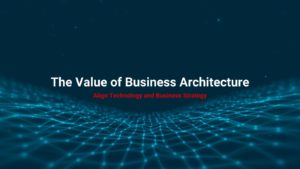IT doesn’t exist as a function for its own sake, IT exists to enable capabilities that a company needs in order to fulfill its business strategy and ultimately deliver returns to investors. But all too often, the linkage between what is being asked of IT, and the value it is intended to deliver to the company can become diluted, unclear, or lost altogether.
Most companies have some semblance of a strategic planning mechanism, either through an in-house group, or sometimes in conjunction with a favored management-consulting firm, like McKinsey, Boston Consulting Group, or Bain Consulting. These groups are typically creative, analytical, and thorough in creating a set of strategic priorities (or themes or pillars) that will enable the company to be successful in its chosen market(s). The best of these efforts will explicitly tie those strategic themes to a measurable expected impact on business outcomes, like a decrease in cost/ unit or an increase in NPS, and how those measures ultimately impact shareholder value creation through revenue, cost, or capital efficiency.
Fewer companies are successful in articulating what the company NEEDS THE ABILITY TO do in order to execute on the strategic theme. This vacuum is typically filled by one of two divide-and-conquer type approaches: (1) special teams are launched against each strategic theme to figure out what needs to be done, or (2) each existing function or business unit is expected to use the strategic themes as guidance for their own cascaded priorities and activities. Neither approach lends itself easily to cross-functional alignment, and often leaders end up justifying existing siloed efforts, or sometimes creating new siloes.
Leadership Alignment is Critical
As discussed in this recent blog post, alignment is critical. Our experiences have taught us that a key to successful (and time and capital-efficient) transformation, is to eliminate the typical blind spot between what a business wants to achieve and the process and technology changes that are actually executed in real life. The key to this is leadership alignment. This requires exercising a cross-functional mindset, at least 1-2 layers deeper than just strategic themes and shareholder value drivers, and inserting a cross-functional lens of “capabilities” between strategy and execution.
Define Your “Ability To Do”
Once a solid strategy is established with clear linkage to how its impact will be measured in business outcomes, the next critical piece is for leaders to agree to a cross-functional view of what set of things the company will need the ABILITY TO DO, in order to achieve each strategic theme. These are plain-language, non-technical statements like “we need the ability to…tailor pricing uniquely for each customer and each transaction”. Even at this level, you will usually begin to see clear patterns and priorities emerging across these “Abilities-To”. While each strategic theme will always have its own set of “Abilities-To”, sometimes they may also overlap between two or more strategic themes, which indicates dependencies between strategic themes, as well as opportunities to leverage effort and investment across themes. For example, the above mentioned “tailor pricing” “Ability-To”, could naturally be a key enabler to two or more strategic themes, perhaps a Customer Experience-related strategic imperative as well as a Supply-Chain Optimization-related strategic imperative.
These “Abilities-To” tend to be composites of numerous, smaller capability building blocks, of the type and level you would find in a true business capability model for your company. Once you’ve translated the higher-level “Abilities-To” into the business capability building blocks that make them up, you will see a similar one-to-many (one “Ability-To” to many capabilities) and many-to-one (many “Abilities-To” to the same capability) set of relationships highlighting both dependencies between, as well as leverage across the “Abilities-To”. This also clarifies important decisions that must be made about prioritization and sequencing of efforts. For example, while a certain pricing capability may be a building block to the “tailor pricing” “Ability-To” mentioned above, it may also potentially be common to numerous other “Abilities-To”, perhaps related to product profitability assessment, or logistics optimization flexibility.
It is critical for a leadership team to be able to work through the full range of linkages, which have been described here (and depicted in Figure One below). This exercise will enable the team to tie that which it is investing in to build (a business capability), to the actual value it expects to deliver (business outcomes).
Do The Work Up Front – Accelerate Transformation Speed
Translating business strategy into business capabilities that can expose dependencies, commonalities, and relationships across strategic themes is a challenging cross-functional, leader-led exercise, but it’s often surprisingly intuitive and eye-opening. Leadership teams that don’t take the time to do this exercise, run the risk of having well-formed strategies that ultimately translate into diffused, and often redundant efforts and investments at the execution level. This makes the path to achieving strategic objectives winding, inefficient, and slow, and it’s often difficult to recover time by throwing more money or people at it.

Figure One
However, those companies with leaders that have a way (and the will) to work as a cross-functional team, beyond high-level strategies and into the concept of business capability prioritization and sequencing, will light the way to a shorter and more efficient path to their current strategic objectives. More importantly, they will also enable IT to renovate the underlying technology engine of the company, so that it will gain the agility, scalability, and speed it will need to remain competitive when markets and strategic objectives ultimately change again.
Author: Kenny Feld, Principal, The Feld Group Institute
Further Learning
Many of these concepts are covered in depth in The Feld Group Institute’s Operationalizing Business Architecture class.
Photo by Ryoji Iwata on Unsplash




